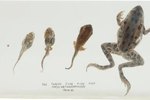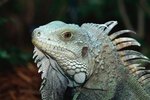
The first amphibians arose about 370 million years ago; since then, they have diverged into more than 7,000 species worldwide. The three major amphibian clades -- frogs, salamanders and the worm-like caecilians -- have each diverged greatly, but share several common characteristics.
Unshelled Eggs
Living amphibians produce much different eggs than strictly terrestrial organisms like reptiles do. The amphibian egg lacks a calcified shell, consisting mostly of jelly -- making it susceptible to rapid desiccation if exposed to the air. While most frogs and salamanders deposit their eggs directly into the water, some species have adapted methods for terrestrial egg deposition. Some terrestrial salamanders deposit their eggs in damp locations under rocks and logs. Some rainforest-dwelling frogs attach their eggs to plant leaves; as they hatch, the young tadpoles drop directly into the water. Amphibians that lay completely terrestrial eggs undergo metamorphosis inside the egg and hatch as fully formed, miniature adults.
Permeable Skin
While caecilians have scales similar to fish, most other amphibians have moist, permeable skin. This forces most species to live in moist or aquatic habitats; otherwise, they would quickly dehydrate as water is lost through the skin. In order to colonize arid habitats, some frogs -- namely waxy monkey frogs (Phyllomedusa sauvagil) -- have developed a protective mechanism: a lipid is secreted from glands in the skin, which the frog spreads over its body with its feet. The lipid helps retard water loss, essentially forming a cocoon around the animal. Many amphibian species produce poisons from glands in the skin that they use to protect themselves from predators; some species -- like some poison dart frogs (Dendrobates sp.) -- possess poisons potent enough to kill humans.
Carnivorous Adults
While some tadpoles and larval salamanders are filter feeders that consume plant and animal material; all adult amphibians are carnivores. While most amphibians consume invertebrates like insects, arachnids and earthworms, some eat small vertebrates as well. American bullfrogs (Rana catesbeiana) are known to eat snakes, fish, rodents and other bullfrogs.
Distribution
Amphibians are found in most parts of the world, but their global distribution shows greatly varying diversity from region to region. Most areas with high amphibian diversity have a few common characteristics, namely warm climates with high annual rainfall. Central and South America, as well as West Africa, are known to have remarkably rich frog fauna; however, sampling in Indonesia and southeast Asia hasn’t been as thorough as it has been in the other areas, and this region may have even more diversity. The southeastern United States is the epicenter of salamander diversity, and the numerous mountains, valleys and small tributary streams of the region have allowed significant speciation to occur as habitats are often geographically isolated from each other.
Courtship Rituals
Frogs are well known for their nightly choruses; males typically move to potential breeding sites and begin calling to attract females. When the females approach, the males clasp them around the back and fertilize the eggs as they are deposited. Salamanders do not vocalize, but many species have ritualized courtship behaviors; some terrestrial species engage in complex dances, but the most developed rituals occur in aquatic species.
References
Photo Credits
-
Jupiterimages/Photos.com/Getty Images



